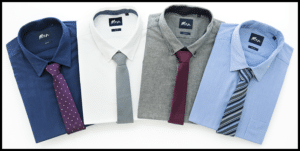
Keeping your clothes wrinkle-free and in tip-top shape during a cross-country move isn’t super-difficult … as long as you follow A2B Moving & Storage’s clothes-packing tips.
Before preparing to pack all those clothes for the moving company in Seattle to transport, think about downsizing your wardrobe. Is that stained T-shirt with the armpit hole doing you any good? Ditch it. (Or repurpose it by using it to wrap a fragile glass lamp.) Out-of-style threads or outfits kids have outgrown provide ideal donation material or even garage-sale inventory.
Cut moving costs
Decluttering experts use a one-year benchmark: If you haven’t worn an item within 12 months (excluding wedding dresses, of course), it’s suitable for “so long.” Obviously, these items don’t require a kid-gloves packing approach, so feel free to toss them in garbage bags for easy transport. You’ll not only eliminate unneeded items that otherwise might tax your new home’s storage capabilities, but you also might decrease the cost of moving.
Once you’ve decided on discards vs. saves, the operative term is “organization.” Clothing will be one of the last things you’ll pack, true, but a last-minute scurrying approach surely will upset your unpacking progress once you move into your new home.
Index your clothes
Get a head start by sorting out those seasonal items. Is it summer? Pack away those winter caps, mittens and heavy coats before everything else. Moving during winter? Start stowing short-sleeved shirts, swimsuits and flip-flops. Also consider separating out items you’re confident you won’t be wearing prior to moving day with your moving company in Bellevue, Washington.
Staying systematic, it’s a great idea to develop an organizing system that resonates with you. Do you group your clothes by color? Separate the blues from the greens from the reds. Perhaps occasion (casual vs. business) is a better indexing method. That means suits won’t be mingled with unstructured jackets, for example. Maybe you group all your slacks and jeans together, no matter how casual or dressy.
Use whichever organizing criteria works best for as you prepare for your cross-country move. Staying consistent during packing will maintain sanity when it comes time to unpack and hang everything up in your new home’s wardrobe closet or stack them in a dresser. You also can develop a parallel system for shoes.
Folding vs. hanging
Once you’ve mentally mapped out how you’ll organize the wardrobe part of your move, it’s time to use our recommended methods for the actual physical packing portion. Avoid previously used boxes. While they might suit the bill for storing less delicate items, the possible presence of bugs or soiling could prove disastrous for your clothes. Consider how discouraging it would be opening up your well-packed clothes in your beautiful new home only to find them stained or infested. Brand-new boxes are ideal clothes-packing containers.
Two main divisions will dictate the packing method at this point: folded vs. hanging. For folded clothes, sturdy smaller boxes will be best. Keeping hanging clothes pristine and wrinkle-free requires using a wardrobe box, which includes a metal bar near the top that allows clothes to be transported on hangers.
Folded clothing should be placed in a packing-paper-lined box. Stuff crumpled paper into any gaps, then close. Exercise caution while hanging clothes in the wardrobe box. Resist the urge to jam-pack items, otherwise wrinkling might result during your interstate move. The final steps for either box type are sealing with packing tape and labeling.
Shoe be do
One more tip: Avoid dropping shoes into the wardrobe-box bottom—as tempting as it might be—as footwear frequently is soiled and might damage clothing.
Instead, wrap shoes separately. First, fill shoes with packing paper to maintain form. Surround one shoe with a packing-paper sheet, then roll the second shoe into the same sheet before taping closed. Place pairs into a box and follow the routine: close, tape and label. Similar to clothing, divide your shoes into keep vs. donate vs. sell categories.
An option for lightweight clothing is not packing it at all. Instead, keep those wearables in your dressers, then move furniture and clothing all at once. Double-check this alternative with your moving companies in Seattle just to be on the safe side.
While having your cross-country movers transport your leather shoes is perfectly fine, we advise you personally transport leather clothing (jackets, skirts and pants) as well as furs, due to their sensitivity to temperature and moisture.
Contact us today
Seeking a moving company in Seattle that’s among the region’s top-rated movers? Whether you need local or long-distance movers, A2B Moving & Storage are the movers in Seattle, WA best-suited to handle the job carefully and courteously. Since 2009, we’ve been the long-distance movers in Auburn, WA people confidently count on. Contact us today for a FREE moving quote: 206.419.5748.
